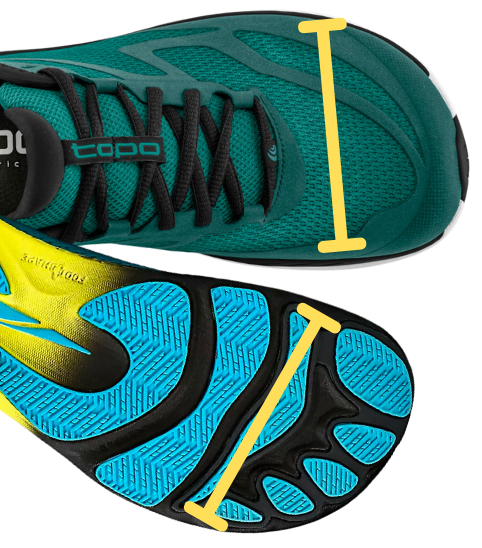Anatomy of a Running Shoe
Even the most experienced and elite runners we see for physical therapt don’t have a great grasp on the makeup of a running shoe and how to go about selecting one. In their defense, there's an endless amount of options and rhetoric out there.
Just 10 years ago, around the release of the book “Born to Run”, the barefoot and minimalist running shoes exploded onto the scene with big claims on running injury statistics. Fast forward to present and we seem to have gone in the opposite direction with the popularity of the highly cushioned “maximalist” running shoes. If the running shoe industry can’t seem to nail down the best option, how can you be expected to?
The important parts of a running shoe
Toe Box
Your forefoot is meant to have a malleable gripping effect that moves and adapts as your foot comes in contact with the ground. A shoe that doesn’t allow this natural spreading of the foot can contribute to numerous foot pathologies such as bunions, bone stress injuries, plantar fasciitis and Morton’s neuroma. Look for a toe box wide enough to accommodate this.
The Midsole, Cushion or “Stack”
The inner layer of foam creating the cushion and support of your shoe. Guidelines to replace your running shoes every 300-500 miles stem from deformation of this foam. If your knees start aching with running after having your shoes for a while, it may be because of this reduction in shock absorption capacity as it wears down. This also means that for 100’s of miles, you’re providing your body with some bounce and support under foot and then taking it away. If your foot doesn’t have the capacity to maintain its integrity for many miles, this can lead to injury. Some runners can’t perceive this change, so track your mileage and look for signs of deformation like creasing in the midsole. If you’re in a true minimal shoe, you don’t have a much cushion, so this may not apply.
Cushioning and foam in shoe provides a little bounce to the runner and thus less demand from the body whereas a minimal running shoe with less cushion places more of the demand on your muscles. The amount of material between your foot and the ground. There are typically two figures, for the heel and the forefoot. Numbers range from 0mm - 40mm and is what differentiates your minimalist and maximalist shoes.
Use these general ranges as a guide:
Minimal: 0 mm - 20 mm
Neutral: ~20 mm - 28-30 mm
Maximalist: 30+ mm
Heel-toe drop or Offset
The drop or offset of a shoe is the difference between your two stack heights. For most modern running shoes, the heel will have a slightly higher stack height than the forefoot creating the ramped down look of the shoe. This is an important variable to pay attention to in regards to foot strike pattern and how the body is loaded. Zero to very low drop shoes encourage a forefoot strike while higher numbers with thick heels are perfectly suited to cushion a heel strike pattern.
This is an important factor for injured runners to consider, especially those dealing with running injuries at the foot, achilles tendinitis, etc. A gait analysis and evaluation by a running physical therapist can give to more guidance on the best running shoe for your body.
Minimal, Neutral and Maximalist Running Shoes vs. Motion Control
Minimalist Shoes
Defining a true minimal running shoe is both a low stack height and drop, without arch support. Think light and flexible with either no midsole or a very thin, soft layer allowing them to be folded up. These usually have very little material protruding around the sole including any flaring out around the forefoot or heel.
Strike Pattern: usually more forefoot or midfoot
Neutral Shoes
The compromise between the extremes of your Vibrams and Hoka’s. A shoe that’s hard to define because really it can have some components of both sides. Generally, think moderate foam material in the midsole, with a moderate drop height and may have some motion control in the arch.
Strike Pattern: usually more midfoot or heel
Maximalist vs. Motion Control Shoes
Motion control defines the intent to reduce the collapse or pronation of your foot. It is the raised, firmer material at the inside of your shoe supporting the arch. The extent of support/motion control can range. The “maximalist” term refers specifically to the large midsole creating a high stack height of the shoe. Heel to toe drop is actually often similar to minimalist, encouraging a midfoot to forefoot strike pattern. In fact, most Hoka’s fall in the 4-5mm drop range intended for forefoot striking.
Strike Pattern: usually more midfoot or heel, depending on drop
Hopefully this helps make you a more educated consumer and encourages you to check out the specs before buying your next pair of shoes. Don’t forget to check out or Ultimate Running Shoe Guide for more info. You can also schedule a gait analysis to get a more informed prescription about what might be the best shoe for you.
In Part 2, we lay out the opposing opinions of the “right” running shoe and strike pattern, when/how to use each type of shoe and discuss some case studies from my our experience treating runners! Especially the importance of being evaluated by a physical therapist to help find the right shoe for you!








